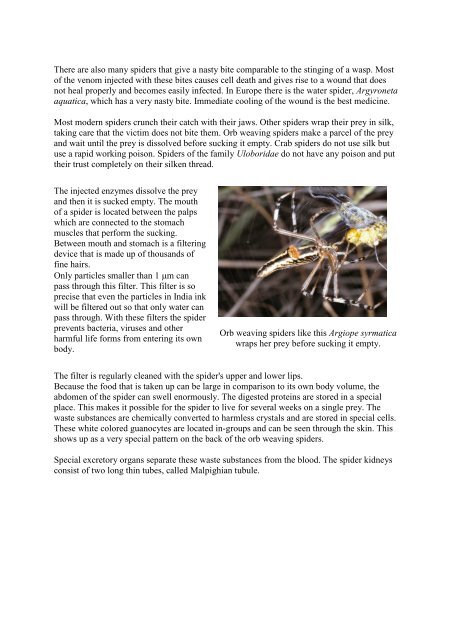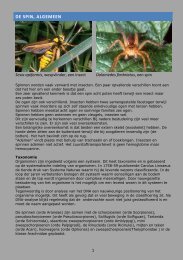The spider.pdf - Spiders from Europe, Australia and some immunology
The spider.pdf - Spiders from Europe, Australia and some immunology
The spider.pdf - Spiders from Europe, Australia and some immunology
You also want an ePaper? Increase the reach of your titles
YUMPU automatically turns print PDFs into web optimized ePapers that Google loves.
<strong>The</strong>re are also many <strong>spider</strong>s that give a nasty bite comparable to the stinging of a wasp. Most<br />
of the venom injected with these bites causes cell death <strong>and</strong> gives rise to a wound that does<br />
not heal properly <strong>and</strong> becomes easily infected. In <strong>Europe</strong> there is the water <strong>spider</strong>, Argyroneta<br />
aquatica, which has a very nasty bite. Immediate cooling of the wound is the best medicine.<br />
Most modern <strong>spider</strong>s crunch their catch with their jaws. Other <strong>spider</strong>s wrap their prey in silk,<br />
taking care that the victim does not bite them. Orb weaving <strong>spider</strong>s make a parcel of the prey<br />
<strong>and</strong> wait until the prey is dissolved before sucking it empty. Crab <strong>spider</strong>s do not use silk but<br />
use a rapid working poison. <strong>Spiders</strong> of the family Uloboridae do not have any poison <strong>and</strong> put<br />
their trust completely on their silken thread.<br />
<strong>The</strong> injected enzymes dissolve the prey<br />
<strong>and</strong> then it is sucked empty. <strong>The</strong> mouth<br />
of a <strong>spider</strong> is located between the palps<br />
which are connected to the stomach<br />
muscles that perform the sucking.<br />
Between mouth <strong>and</strong> stomach is a filtering<br />
device that is made up of thous<strong>and</strong>s of<br />
fine hairs.<br />
Only particles smaller than 1 m can<br />
pass through this filter. This filter is so<br />
precise that even the particles in India ink<br />
will be filtered out so that only water can<br />
pass through. With these filters the <strong>spider</strong><br />
prevents bacteria, viruses <strong>and</strong> other<br />
harmful life forms <strong>from</strong> entering its own<br />
body.<br />
Orb weaving <strong>spider</strong>s like this Argiope syrmatica<br />
wraps her prey before sucking it empty.<br />
<strong>The</strong> filter is regularly cleaned with the <strong>spider</strong>'s upper <strong>and</strong> lower lips.<br />
Because the food that is taken up can be large in comparison to its own body volume, the<br />
abdomen of the <strong>spider</strong> can swell enormously. <strong>The</strong> digested proteins are stored in a special<br />
place. This makes it possible for the <strong>spider</strong> to live for several weeks on a single prey. <strong>The</strong><br />
waste substances are chemically converted to harmless crystals <strong>and</strong> are stored in special cells.<br />
<strong>The</strong>se white colored guanocytes are located in-groups <strong>and</strong> can be seen through the skin. This<br />
shows up as a very special pattern on the back of the orb weaving <strong>spider</strong>s.<br />
Special excretory organs separate these waste substances <strong>from</strong> the blood. <strong>The</strong> <strong>spider</strong> kidneys<br />
consist of two long thin tubes, called Malpighian tubule.



